Sustainable Tourism Development Planning: Doc
VerifiedAdded on 2021/01/02
|17
|5055
|116
AI Summary
Contribute Materials
Your contribution can guide someone’s learning journey. Share your
documents today.
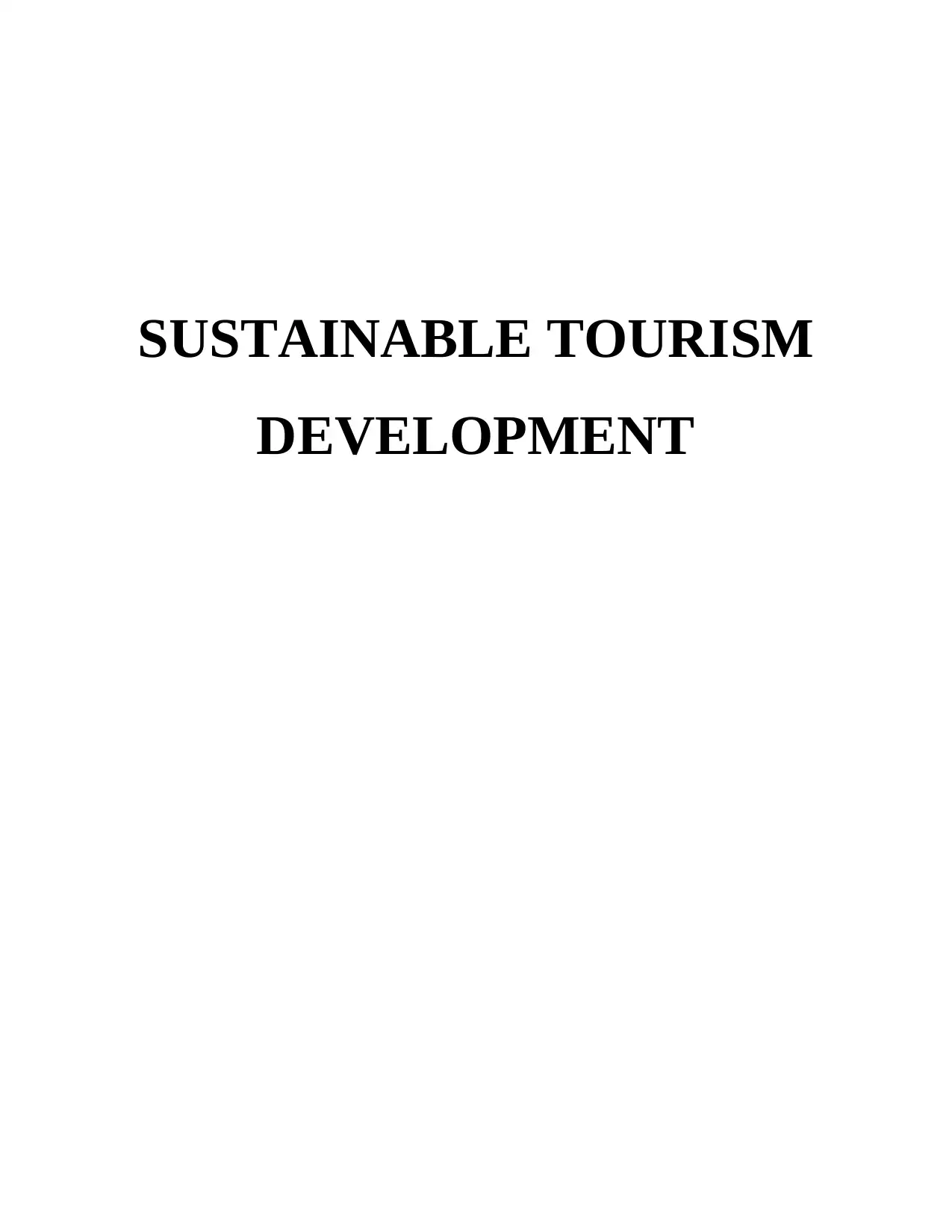
SUSTAINABLE TOURISM
DEVELOPMENT
DEVELOPMENT
Secure Best Marks with AI Grader
Need help grading? Try our AI Grader for instant feedback on your assignments.

Table of Contents
INTRODUCTION...........................................................................................................................1
TASK 1............................................................................................................................................1
1.1 How stakeholder can benefit from planning of tourism development .................................1
1.2 Advantages and disadvantage of public and private sector tourism planning partnership . .2
TASK 2............................................................................................................................................3
2.1 Features of tourism development planning at different levels..............................................3
2.2 Significance of interactive planning system and process in tourism development...............4
2.3 Different methods available to measure tourist impact ........................................................5
TASK 3............................................................................................................................................5
3.1 and 3.2 covered in poster......................................................................................................5
3.3 Stages in planning for sustainability with reference to Philippine........................................5
TASK 4............................................................................................................................................6
4.1 Methods of resolving conflict of interest to ensure future well-being to develop tourism
destination...................................................................................................................................6
4.2 Implications of balancing supply and demand with Philippine case study...........................7
4.3 Moral and ethical issues of enclave tourism.........................................................................8
TASK 5............................................................................................................................................8
5.1 Compare current issues associated with tourism development in developing nation...........8
5.2 Recommendations for future development of tourism in chosen destination.......................9
CONCLUSION..............................................................................................................................10
REFERENCES .............................................................................................................................11
INTRODUCTION...........................................................................................................................1
TASK 1............................................................................................................................................1
1.1 How stakeholder can benefit from planning of tourism development .................................1
1.2 Advantages and disadvantage of public and private sector tourism planning partnership . .2
TASK 2............................................................................................................................................3
2.1 Features of tourism development planning at different levels..............................................3
2.2 Significance of interactive planning system and process in tourism development...............4
2.3 Different methods available to measure tourist impact ........................................................5
TASK 3............................................................................................................................................5
3.1 and 3.2 covered in poster......................................................................................................5
3.3 Stages in planning for sustainability with reference to Philippine........................................5
TASK 4............................................................................................................................................6
4.1 Methods of resolving conflict of interest to ensure future well-being to develop tourism
destination...................................................................................................................................6
4.2 Implications of balancing supply and demand with Philippine case study...........................7
4.3 Moral and ethical issues of enclave tourism.........................................................................8
TASK 5............................................................................................................................................8
5.1 Compare current issues associated with tourism development in developing nation...........8
5.2 Recommendations for future development of tourism in chosen destination.......................9
CONCLUSION..............................................................................................................................10
REFERENCES .............................................................................................................................11

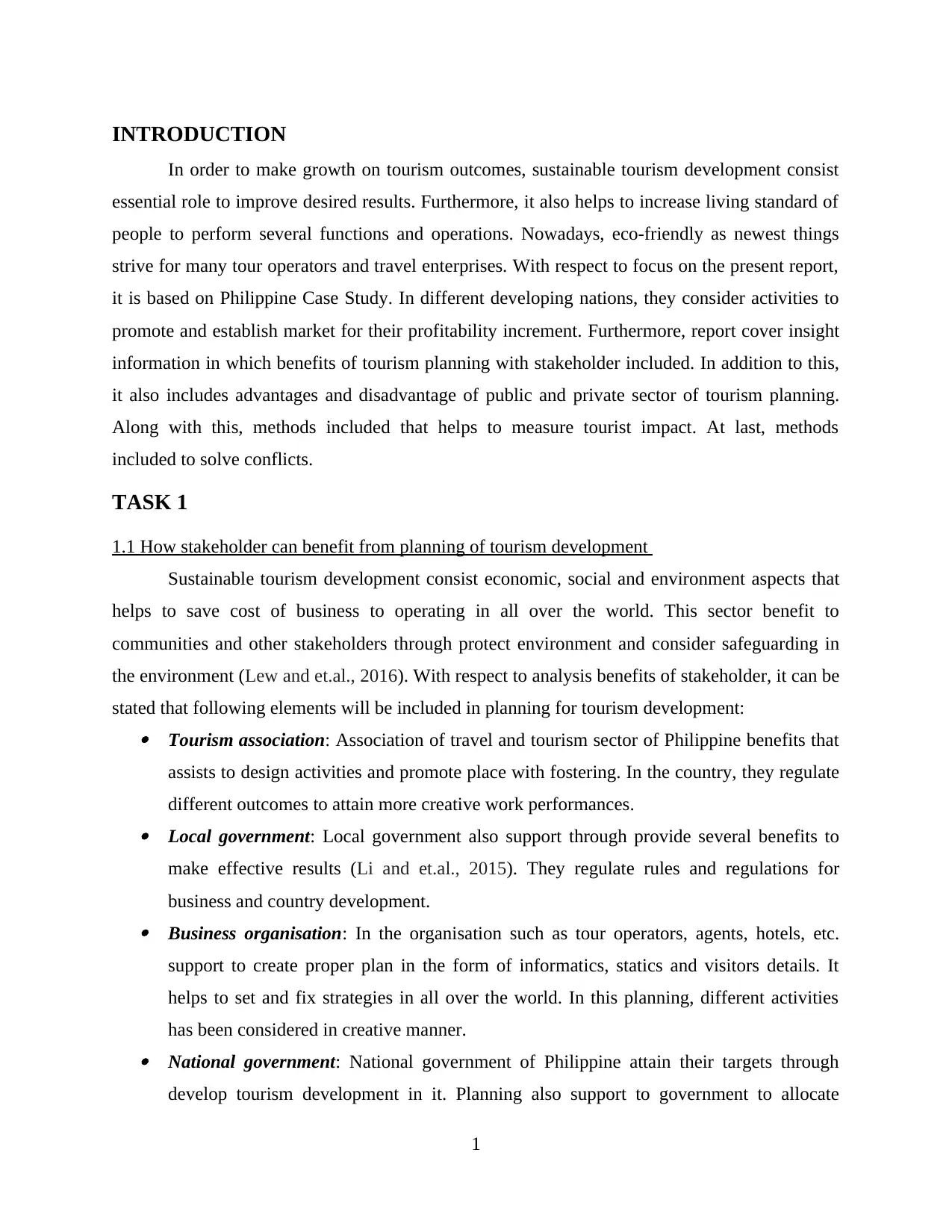
INTRODUCTION
In order to make growth on tourism outcomes, sustainable tourism development consist
essential role to improve desired results. Furthermore, it also helps to increase living standard of
people to perform several functions and operations. Nowadays, eco-friendly as newest things
strive for many tour operators and travel enterprises. With respect to focus on the present report,
it is based on Philippine Case Study. In different developing nations, they consider activities to
promote and establish market for their profitability increment. Furthermore, report cover insight
information in which benefits of tourism planning with stakeholder included. In addition to this,
it also includes advantages and disadvantage of public and private sector of tourism planning.
Along with this, methods included that helps to measure tourist impact. At last, methods
included to solve conflicts.
TASK 1
1.1 How stakeholder can benefit from planning of tourism development
Sustainable tourism development consist economic, social and environment aspects that
helps to save cost of business to operating in all over the world. This sector benefit to
communities and other stakeholders through protect environment and consider safeguarding in
the environment (Lew and et.al., 2016). With respect to analysis benefits of stakeholder, it can be
stated that following elements will be included in planning for tourism development: Tourism association: Association of travel and tourism sector of Philippine benefits that
assists to design activities and promote place with fostering. In the country, they regulate
different outcomes to attain more creative work performances. Local government: Local government also support through provide several benefits to
make effective results (Li and et.al., 2015). They regulate rules and regulations for
business and country development. Business organisation: In the organisation such as tour operators, agents, hotels, etc.
support to create proper plan in the form of informatics, statics and visitors details. It
helps to set and fix strategies in all over the world. In this planning, different activities
has been considered in creative manner. National government: National government of Philippine attain their targets through
develop tourism development in it. Planning also support to government to allocate
1
In order to make growth on tourism outcomes, sustainable tourism development consist
essential role to improve desired results. Furthermore, it also helps to increase living standard of
people to perform several functions and operations. Nowadays, eco-friendly as newest things
strive for many tour operators and travel enterprises. With respect to focus on the present report,
it is based on Philippine Case Study. In different developing nations, they consider activities to
promote and establish market for their profitability increment. Furthermore, report cover insight
information in which benefits of tourism planning with stakeholder included. In addition to this,
it also includes advantages and disadvantage of public and private sector of tourism planning.
Along with this, methods included that helps to measure tourist impact. At last, methods
included to solve conflicts.
TASK 1
1.1 How stakeholder can benefit from planning of tourism development
Sustainable tourism development consist economic, social and environment aspects that
helps to save cost of business to operating in all over the world. This sector benefit to
communities and other stakeholders through protect environment and consider safeguarding in
the environment (Lew and et.al., 2016). With respect to analysis benefits of stakeholder, it can be
stated that following elements will be included in planning for tourism development: Tourism association: Association of travel and tourism sector of Philippine benefits that
assists to design activities and promote place with fostering. In the country, they regulate
different outcomes to attain more creative work performances. Local government: Local government also support through provide several benefits to
make effective results (Li and et.al., 2015). They regulate rules and regulations for
business and country development. Business organisation: In the organisation such as tour operators, agents, hotels, etc.
support to create proper plan in the form of informatics, statics and visitors details. It
helps to set and fix strategies in all over the world. In this planning, different activities
has been considered in creative manner. National government: National government of Philippine attain their targets through
develop tourism development in it. Planning also support to government to allocate
1
Secure Best Marks with AI Grader
Need help grading? Try our AI Grader for instant feedback on your assignments.
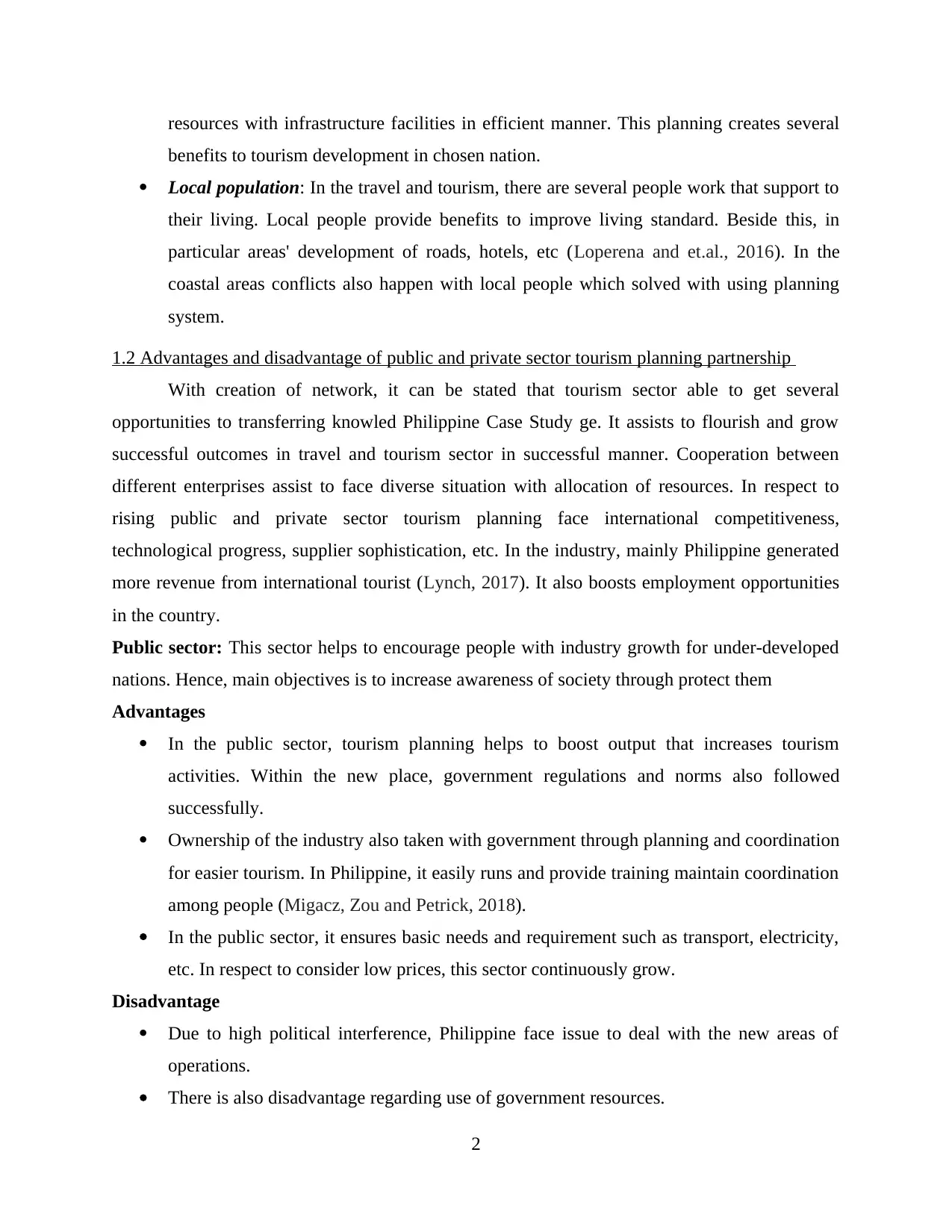
resources with infrastructure facilities in efficient manner. This planning creates several
benefits to tourism development in chosen nation.
Local population: In the travel and tourism, there are several people work that support to
their living. Local people provide benefits to improve living standard. Beside this, in
particular areas' development of roads, hotels, etc (Loperena and et.al., 2016). In the
coastal areas conflicts also happen with local people which solved with using planning
system.
1.2 Advantages and disadvantage of public and private sector tourism planning partnership
With creation of network, it can be stated that tourism sector able to get several
opportunities to transferring knowled Philippine Case Study ge. It assists to flourish and grow
successful outcomes in travel and tourism sector in successful manner. Cooperation between
different enterprises assist to face diverse situation with allocation of resources. In respect to
rising public and private sector tourism planning face international competitiveness,
technological progress, supplier sophistication, etc. In the industry, mainly Philippine generated
more revenue from international tourist (Lynch, 2017). It also boosts employment opportunities
in the country.
Public sector: This sector helps to encourage people with industry growth for under-developed
nations. Hence, main objectives is to increase awareness of society through protect them
Advantages
In the public sector, tourism planning helps to boost output that increases tourism
activities. Within the new place, government regulations and norms also followed
successfully.
Ownership of the industry also taken with government through planning and coordination
for easier tourism. In Philippine, it easily runs and provide training maintain coordination
among people (Migacz, Zou and Petrick, 2018).
In the public sector, it ensures basic needs and requirement such as transport, electricity,
etc. In respect to consider low prices, this sector continuously grow.
Disadvantage
Due to high political interference, Philippine face issue to deal with the new areas of
operations.
There is also disadvantage regarding use of government resources.
2
benefits to tourism development in chosen nation.
Local population: In the travel and tourism, there are several people work that support to
their living. Local people provide benefits to improve living standard. Beside this, in
particular areas' development of roads, hotels, etc (Loperena and et.al., 2016). In the
coastal areas conflicts also happen with local people which solved with using planning
system.
1.2 Advantages and disadvantage of public and private sector tourism planning partnership
With creation of network, it can be stated that tourism sector able to get several
opportunities to transferring knowled Philippine Case Study ge. It assists to flourish and grow
successful outcomes in travel and tourism sector in successful manner. Cooperation between
different enterprises assist to face diverse situation with allocation of resources. In respect to
rising public and private sector tourism planning face international competitiveness,
technological progress, supplier sophistication, etc. In the industry, mainly Philippine generated
more revenue from international tourist (Lynch, 2017). It also boosts employment opportunities
in the country.
Public sector: This sector helps to encourage people with industry growth for under-developed
nations. Hence, main objectives is to increase awareness of society through protect them
Advantages
In the public sector, tourism planning helps to boost output that increases tourism
activities. Within the new place, government regulations and norms also followed
successfully.
Ownership of the industry also taken with government through planning and coordination
for easier tourism. In Philippine, it easily runs and provide training maintain coordination
among people (Migacz, Zou and Petrick, 2018).
In the public sector, it ensures basic needs and requirement such as transport, electricity,
etc. In respect to consider low prices, this sector continuously grow.
Disadvantage
Due to high political interference, Philippine face issue to deal with the new areas of
operations.
There is also disadvantage regarding use of government resources.
2
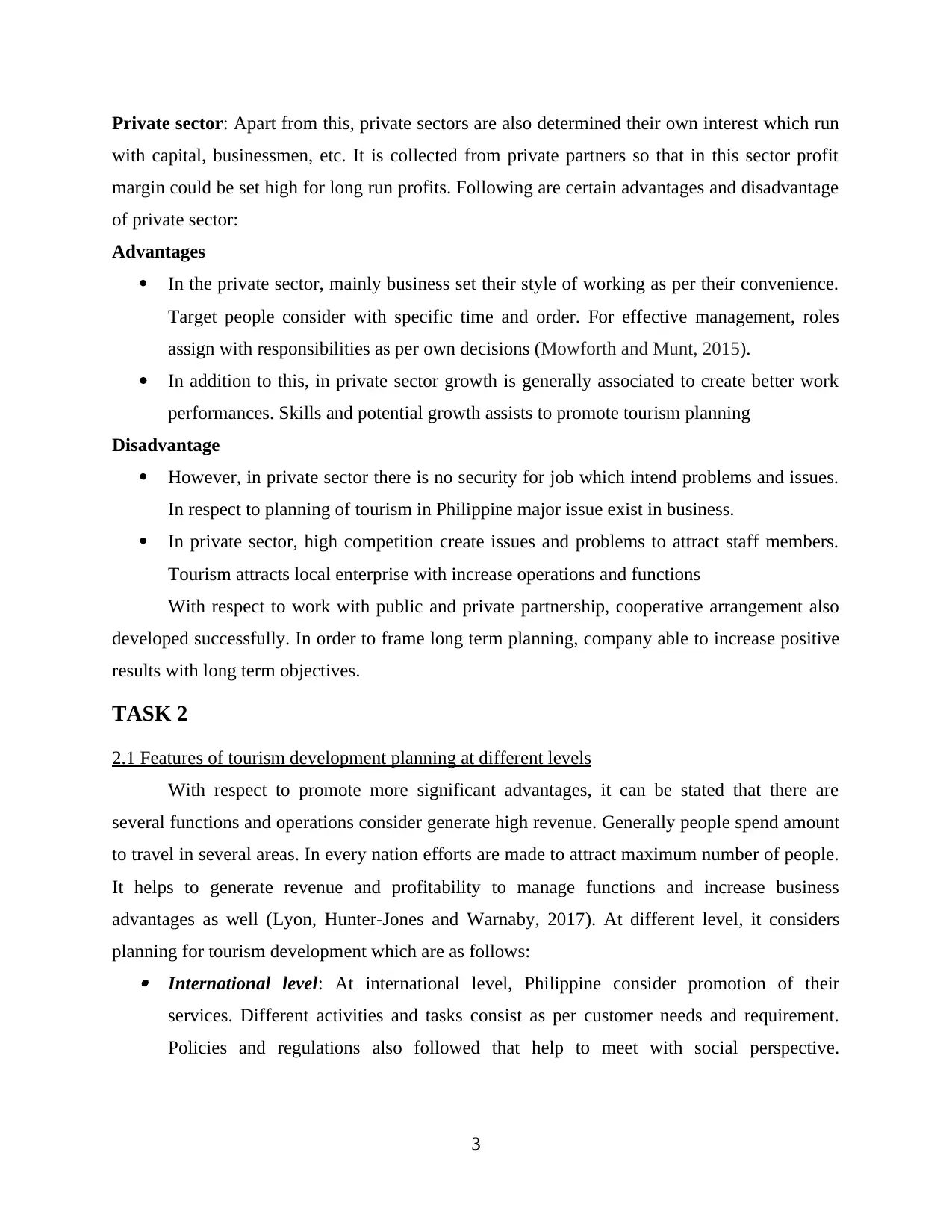
Private sector: Apart from this, private sectors are also determined their own interest which run
with capital, businessmen, etc. It is collected from private partners so that in this sector profit
margin could be set high for long run profits. Following are certain advantages and disadvantage
of private sector:
Advantages
In the private sector, mainly business set their style of working as per their convenience.
Target people consider with specific time and order. For effective management, roles
assign with responsibilities as per own decisions (Mowforth and Munt, 2015).
In addition to this, in private sector growth is generally associated to create better work
performances. Skills and potential growth assists to promote tourism planning
Disadvantage
However, in private sector there is no security for job which intend problems and issues.
In respect to planning of tourism in Philippine major issue exist in business.
In private sector, high competition create issues and problems to attract staff members.
Tourism attracts local enterprise with increase operations and functions
With respect to work with public and private partnership, cooperative arrangement also
developed successfully. In order to frame long term planning, company able to increase positive
results with long term objectives.
TASK 2
2.1 Features of tourism development planning at different levels
With respect to promote more significant advantages, it can be stated that there are
several functions and operations consider generate high revenue. Generally people spend amount
to travel in several areas. In every nation efforts are made to attract maximum number of people.
It helps to generate revenue and profitability to manage functions and increase business
advantages as well (Lyon, Hunter-Jones and Warnaby, 2017). At different level, it considers
planning for tourism development which are as follows: International level: At international level, Philippine consider promotion of their
services. Different activities and tasks consist as per customer needs and requirement.
Policies and regulations also followed that help to meet with social perspective.
3
with capital, businessmen, etc. It is collected from private partners so that in this sector profit
margin could be set high for long run profits. Following are certain advantages and disadvantage
of private sector:
Advantages
In the private sector, mainly business set their style of working as per their convenience.
Target people consider with specific time and order. For effective management, roles
assign with responsibilities as per own decisions (Mowforth and Munt, 2015).
In addition to this, in private sector growth is generally associated to create better work
performances. Skills and potential growth assists to promote tourism planning
Disadvantage
However, in private sector there is no security for job which intend problems and issues.
In respect to planning of tourism in Philippine major issue exist in business.
In private sector, high competition create issues and problems to attract staff members.
Tourism attracts local enterprise with increase operations and functions
With respect to work with public and private partnership, cooperative arrangement also
developed successfully. In order to frame long term planning, company able to increase positive
results with long term objectives.
TASK 2
2.1 Features of tourism development planning at different levels
With respect to promote more significant advantages, it can be stated that there are
several functions and operations consider generate high revenue. Generally people spend amount
to travel in several areas. In every nation efforts are made to attract maximum number of people.
It helps to generate revenue and profitability to manage functions and increase business
advantages as well (Lyon, Hunter-Jones and Warnaby, 2017). At different level, it considers
planning for tourism development which are as follows: International level: At international level, Philippine consider promotion of their
services. Different activities and tasks consist as per customer needs and requirement.
Policies and regulations also followed that help to meet with social perspective.
3
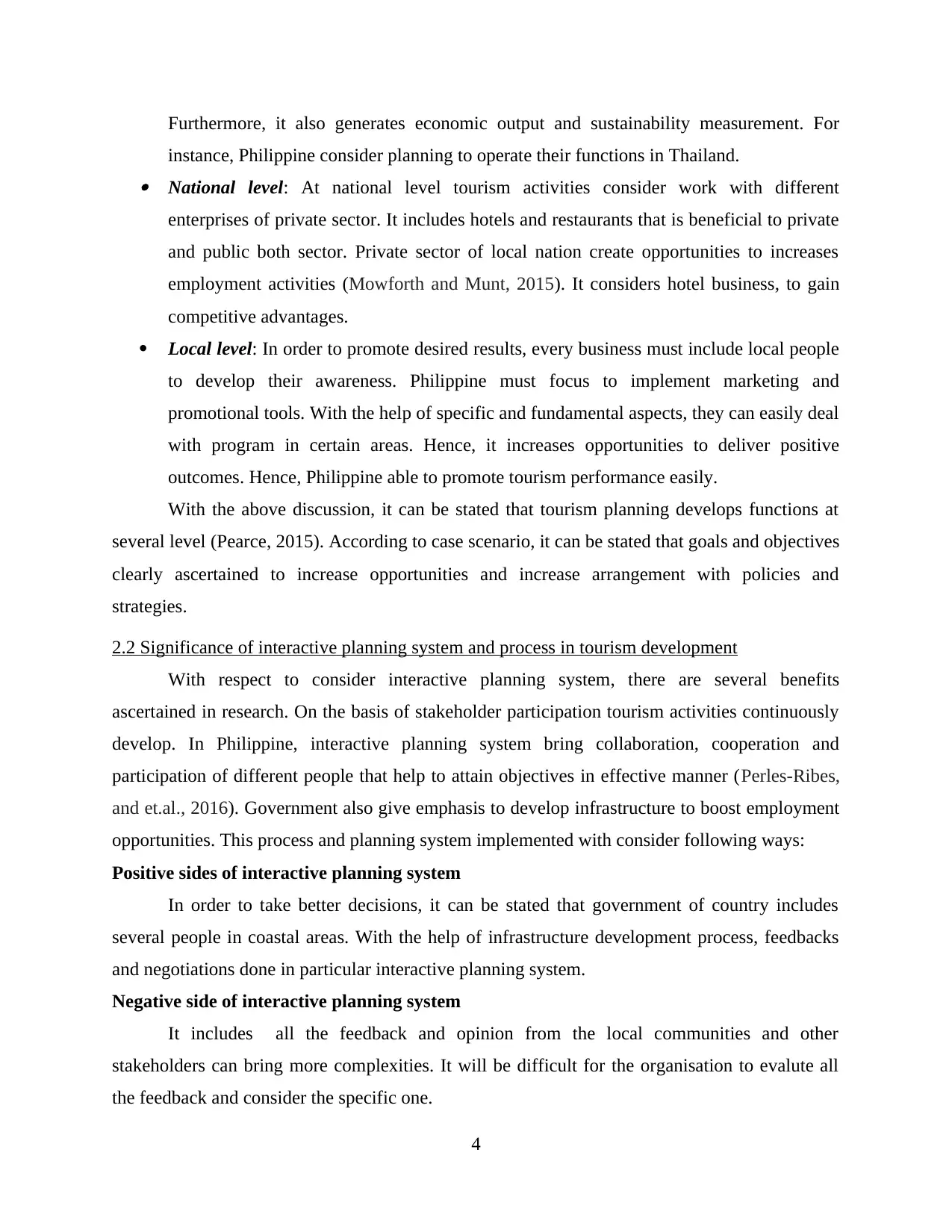
Furthermore, it also generates economic output and sustainability measurement. For
instance, Philippine consider planning to operate their functions in Thailand. National level: At national level tourism activities consider work with different
enterprises of private sector. It includes hotels and restaurants that is beneficial to private
and public both sector. Private sector of local nation create opportunities to increases
employment activities (Mowforth and Munt, 2015). It considers hotel business, to gain
competitive advantages.
Local level: In order to promote desired results, every business must include local people
to develop their awareness. Philippine must focus to implement marketing and
promotional tools. With the help of specific and fundamental aspects, they can easily deal
with program in certain areas. Hence, it increases opportunities to deliver positive
outcomes. Hence, Philippine able to promote tourism performance easily.
With the above discussion, it can be stated that tourism planning develops functions at
several level (Pearce, 2015). According to case scenario, it can be stated that goals and objectives
clearly ascertained to increase opportunities and increase arrangement with policies and
strategies.
2.2 Significance of interactive planning system and process in tourism development
With respect to consider interactive planning system, there are several benefits
ascertained in research. On the basis of stakeholder participation tourism activities continuously
develop. In Philippine, interactive planning system bring collaboration, cooperation and
participation of different people that help to attain objectives in effective manner (Perles-Ribes,
and et.al., 2016). Government also give emphasis to develop infrastructure to boost employment
opportunities. This process and planning system implemented with consider following ways:
Positive sides of interactive planning system
In order to take better decisions, it can be stated that government of country includes
several people in coastal areas. With the help of infrastructure development process, feedbacks
and negotiations done in particular interactive planning system.
Negative side of interactive planning system
It includes all the feedback and opinion from the local communities and other
stakeholders can bring more complexities. It will be difficult for the organisation to evalute all
the feedback and consider the specific one.
4
instance, Philippine consider planning to operate their functions in Thailand. National level: At national level tourism activities consider work with different
enterprises of private sector. It includes hotels and restaurants that is beneficial to private
and public both sector. Private sector of local nation create opportunities to increases
employment activities (Mowforth and Munt, 2015). It considers hotel business, to gain
competitive advantages.
Local level: In order to promote desired results, every business must include local people
to develop their awareness. Philippine must focus to implement marketing and
promotional tools. With the help of specific and fundamental aspects, they can easily deal
with program in certain areas. Hence, it increases opportunities to deliver positive
outcomes. Hence, Philippine able to promote tourism performance easily.
With the above discussion, it can be stated that tourism planning develops functions at
several level (Pearce, 2015). According to case scenario, it can be stated that goals and objectives
clearly ascertained to increase opportunities and increase arrangement with policies and
strategies.
2.2 Significance of interactive planning system and process in tourism development
With respect to consider interactive planning system, there are several benefits
ascertained in research. On the basis of stakeholder participation tourism activities continuously
develop. In Philippine, interactive planning system bring collaboration, cooperation and
participation of different people that help to attain objectives in effective manner (Perles-Ribes,
and et.al., 2016). Government also give emphasis to develop infrastructure to boost employment
opportunities. This process and planning system implemented with consider following ways:
Positive sides of interactive planning system
In order to take better decisions, it can be stated that government of country includes
several people in coastal areas. With the help of infrastructure development process, feedbacks
and negotiations done in particular interactive planning system.
Negative side of interactive planning system
It includes all the feedback and opinion from the local communities and other
stakeholders can bring more complexities. It will be difficult for the organisation to evalute all
the feedback and consider the specific one.
4
Paraphrase This Document
Need a fresh take? Get an instant paraphrase of this document with our AI Paraphraser
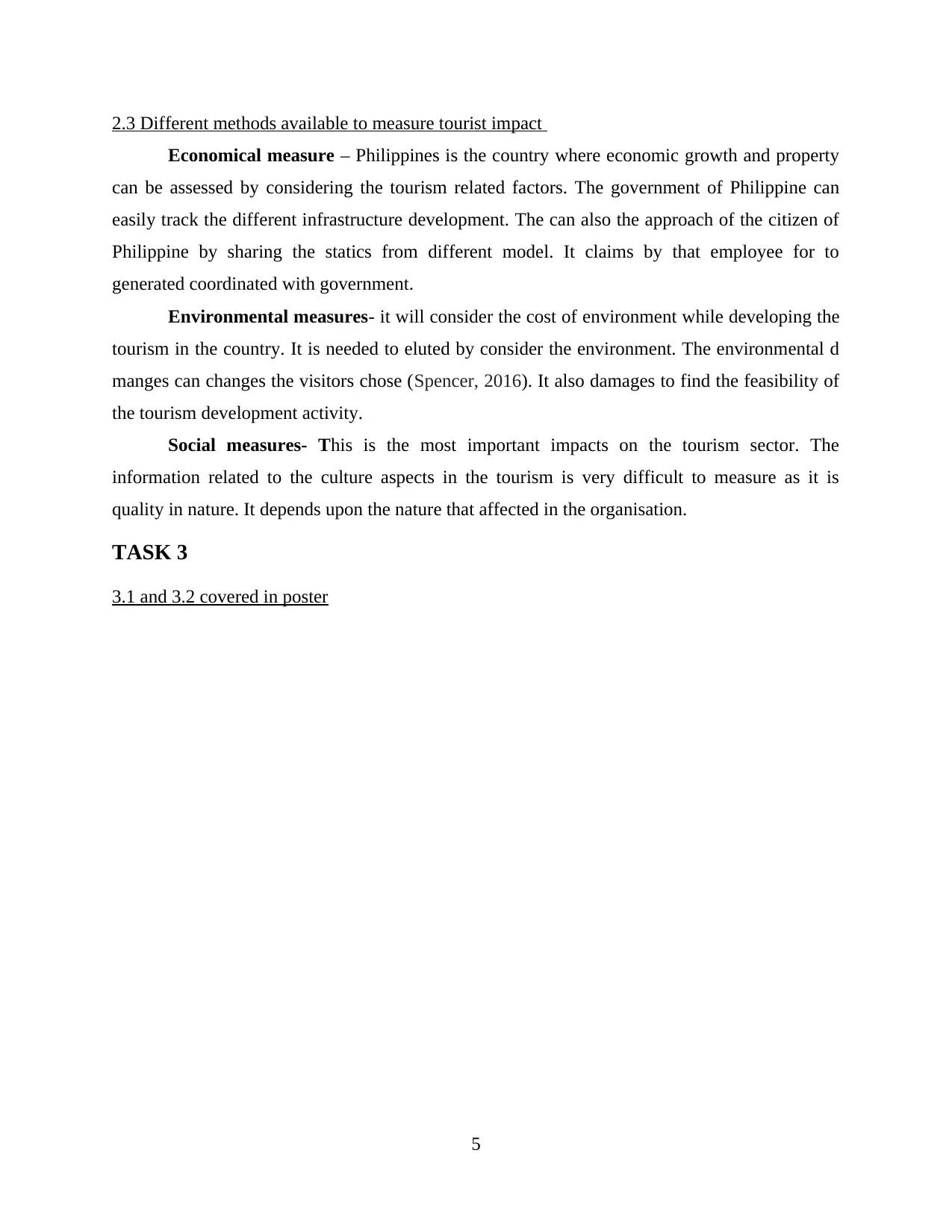
2.3 Different methods available to measure tourist impact
Economical measure – Philippines is the country where economic growth and property
can be assessed by considering the tourism related factors. The government of Philippine can
easily track the different infrastructure development. The can also the approach of the citizen of
Philippine by sharing the statics from different model. It claims by that employee for to
generated coordinated with government.
Environmental measures- it will consider the cost of environment while developing the
tourism in the country. It is needed to eluted by consider the environment. The environmental d
manges can changes the visitors chose (Spencer, 2016). It also damages to find the feasibility of
the tourism development activity.
Social measures- This is the most important impacts on the tourism sector. The
information related to the culture aspects in the tourism is very difficult to measure as it is
quality in nature. It depends upon the nature that affected in the organisation.
TASK 3
3.1 and 3.2 covered in poster
5
Economical measure – Philippines is the country where economic growth and property
can be assessed by considering the tourism related factors. The government of Philippine can
easily track the different infrastructure development. The can also the approach of the citizen of
Philippine by sharing the statics from different model. It claims by that employee for to
generated coordinated with government.
Environmental measures- it will consider the cost of environment while developing the
tourism in the country. It is needed to eluted by consider the environment. The environmental d
manges can changes the visitors chose (Spencer, 2016). It also damages to find the feasibility of
the tourism development activity.
Social measures- This is the most important impacts on the tourism sector. The
information related to the culture aspects in the tourism is very difficult to measure as it is
quality in nature. It depends upon the nature that affected in the organisation.
TASK 3
3.1 and 3.2 covered in poster
5
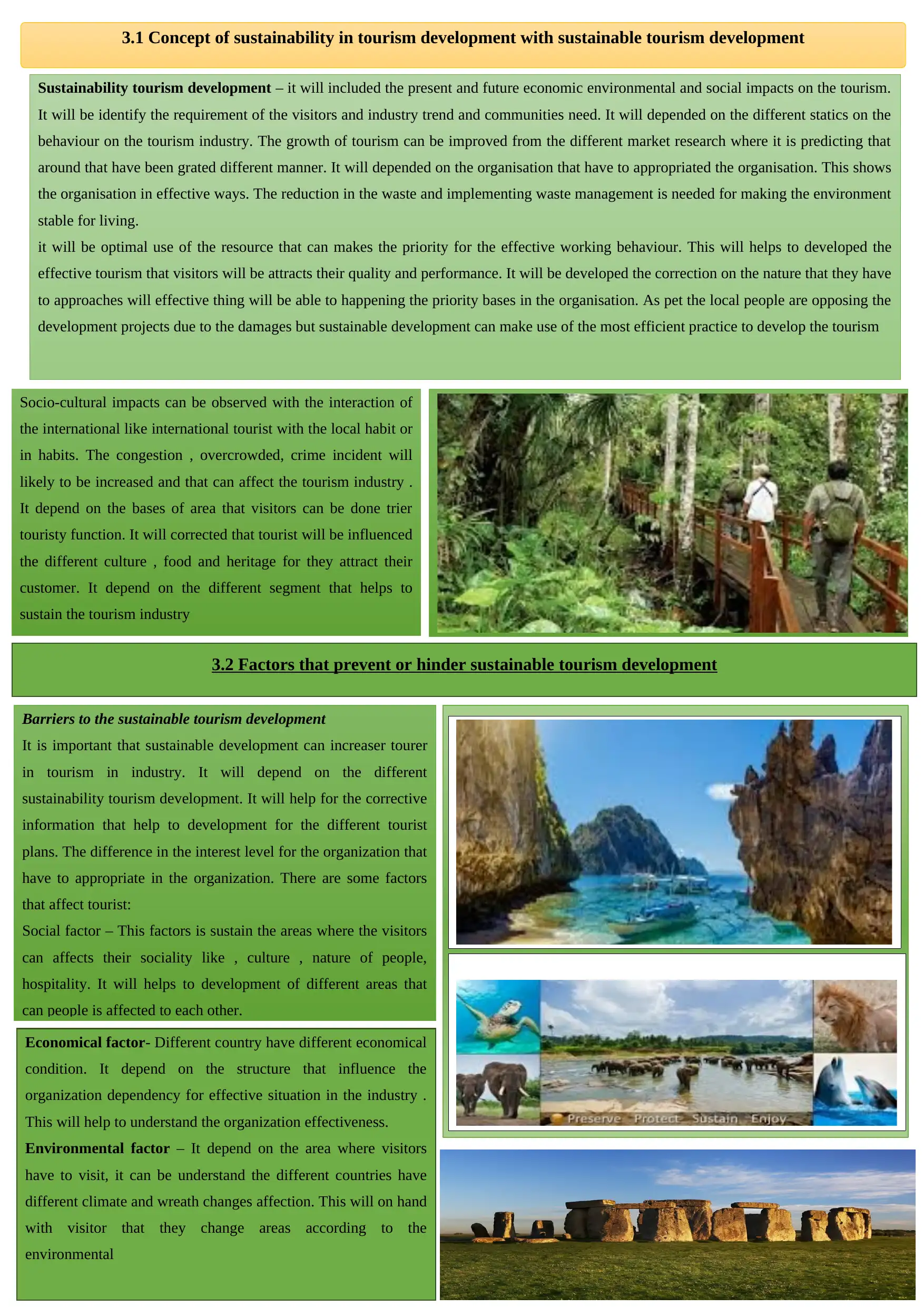
6
Barriers to the sustainable tourism development
It is important that sustainable development can increaser tourer
in tourism in industry. It will depend on the different
sustainability tourism development. It will help for the corrective
information that help to development for the different tourist
plans. The difference in the interest level for the organization that
have to appropriate in the organization. There are some factors
that affect tourist:
Social factor – This factors is sustain the areas where the visitors
can affects their sociality like , culture , nature of people,
hospitality. It will helps to development of different areas that
can people is affected to each other.
Sustainability tourism development – it will included the present and future economic environmental and social impacts on the tourism.
It will be identify the requirement of the visitors and industry trend and communities need. It will depended on the different statics on the
behaviour on the tourism industry. The growth of tourism can be improved from the different market research where it is predicting that
around that have been grated different manner. It will depended on the organisation that have to appropriated the organisation. This shows
the organisation in effective ways. The reduction in the waste and implementing waste management is needed for making the environment
stable for living.
it will be optimal use of the resource that can makes the priority for the effective working behaviour. This will helps to developed the
effective tourism that visitors will be attracts their quality and performance. It will be developed the correction on the nature that they have
to approaches will effective thing will be able to happening the priority bases in the organisation. As pet the local people are opposing the
development projects due to the damages but sustainable development can make use of the most efficient practice to develop the tourism
3.1 Concept of sustainability in tourism development with sustainable tourism development
Socio-cultural impacts can be observed with the interaction of
the international like international tourist with the local habit or
in habits. The congestion , overcrowded, crime incident will
likely to be increased and that can affect the tourism industry .
It depend on the bases of area that visitors can be done trier
touristy function. It will corrected that tourist will be influenced
the different culture , food and heritage for they attract their
customer. It depend on the different segment that helps to
sustain the tourism industry
3.2 Factors that prevent or hinder sustainable tourism development
Economical factor- Different country have different economical
condition. It depend on the structure that influence the
organization dependency for effective situation in the industry .
This will help to understand the organization effectiveness.
Environmental factor – It depend on the area where visitors
have to visit, it can be understand the different countries have
different climate and wreath changes affection. This will on hand
with visitor that they change areas according to the
environmental
Barriers to the sustainable tourism development
It is important that sustainable development can increaser tourer
in tourism in industry. It will depend on the different
sustainability tourism development. It will help for the corrective
information that help to development for the different tourist
plans. The difference in the interest level for the organization that
have to appropriate in the organization. There are some factors
that affect tourist:
Social factor – This factors is sustain the areas where the visitors
can affects their sociality like , culture , nature of people,
hospitality. It will helps to development of different areas that
can people is affected to each other.
Sustainability tourism development – it will included the present and future economic environmental and social impacts on the tourism.
It will be identify the requirement of the visitors and industry trend and communities need. It will depended on the different statics on the
behaviour on the tourism industry. The growth of tourism can be improved from the different market research where it is predicting that
around that have been grated different manner. It will depended on the organisation that have to appropriated the organisation. This shows
the organisation in effective ways. The reduction in the waste and implementing waste management is needed for making the environment
stable for living.
it will be optimal use of the resource that can makes the priority for the effective working behaviour. This will helps to developed the
effective tourism that visitors will be attracts their quality and performance. It will be developed the correction on the nature that they have
to approaches will effective thing will be able to happening the priority bases in the organisation. As pet the local people are opposing the
development projects due to the damages but sustainable development can make use of the most efficient practice to develop the tourism
3.1 Concept of sustainability in tourism development with sustainable tourism development
Socio-cultural impacts can be observed with the interaction of
the international like international tourist with the local habit or
in habits. The congestion , overcrowded, crime incident will
likely to be increased and that can affect the tourism industry .
It depend on the bases of area that visitors can be done trier
touristy function. It will corrected that tourist will be influenced
the different culture , food and heritage for they attract their
customer. It depend on the different segment that helps to
sustain the tourism industry
3.2 Factors that prevent or hinder sustainable tourism development
Economical factor- Different country have different economical
condition. It depend on the structure that influence the
organization dependency for effective situation in the industry .
This will help to understand the organization effectiveness.
Environmental factor – It depend on the area where visitors
have to visit, it can be understand the different countries have
different climate and wreath changes affection. This will on hand
with visitor that they change areas according to the
environmental
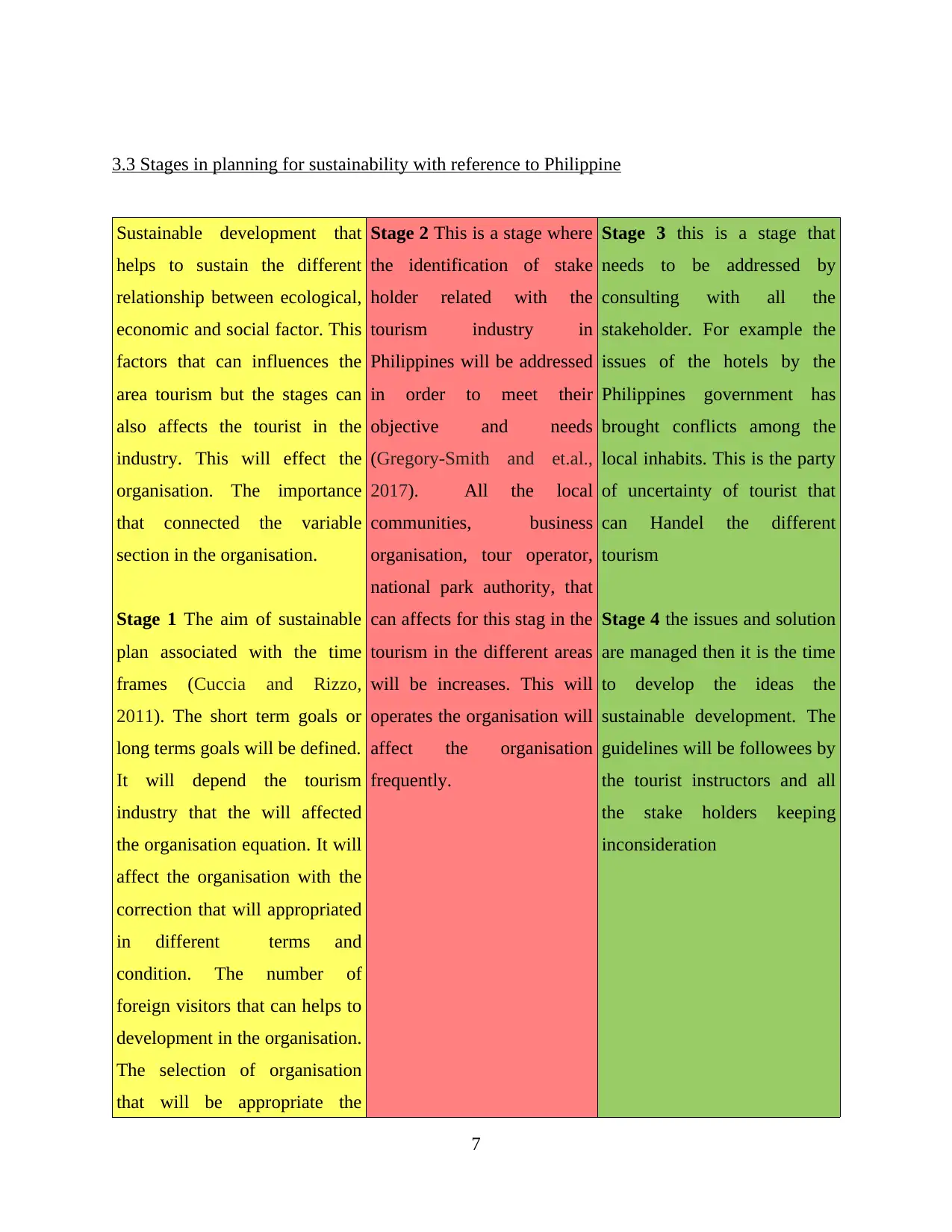
3.3 Stages in planning for sustainability with reference to Philippine
Sustainable development that
helps to sustain the different
relationship between ecological,
economic and social factor. This
factors that can influences the
area tourism but the stages can
also affects the tourist in the
industry. This will effect the
organisation. The importance
that connected the variable
section in the organisation.
Stage 1 The aim of sustainable
plan associated with the time
frames (Cuccia and Rizzo,
2011). The short term goals or
long terms goals will be defined.
It will depend the tourism
industry that the will affected
the organisation equation. It will
affect the organisation with the
correction that will appropriated
in different terms and
condition. The number of
foreign visitors that can helps to
development in the organisation.
The selection of organisation
that will be appropriate the
Stage 2 This is a stage where
the identification of stake
holder related with the
tourism industry in
Philippines will be addressed
in order to meet their
objective and needs
(Gregory-Smith and et.al.,
2017). All the local
communities, business
organisation, tour operator,
national park authority, that
can affects for this stag in the
tourism in the different areas
will be increases. This will
operates the organisation will
affect the organisation
frequently.
Stage 3 this is a stage that
needs to be addressed by
consulting with all the
stakeholder. For example the
issues of the hotels by the
Philippines government has
brought conflicts among the
local inhabits. This is the party
of uncertainty of tourist that
can Handel the different
tourism
Stage 4 the issues and solution
are managed then it is the time
to develop the ideas the
sustainable development. The
guidelines will be followees by
the tourist instructors and all
the stake holders keeping
inconsideration
7
Sustainable development that
helps to sustain the different
relationship between ecological,
economic and social factor. This
factors that can influences the
area tourism but the stages can
also affects the tourist in the
industry. This will effect the
organisation. The importance
that connected the variable
section in the organisation.
Stage 1 The aim of sustainable
plan associated with the time
frames (Cuccia and Rizzo,
2011). The short term goals or
long terms goals will be defined.
It will depend the tourism
industry that the will affected
the organisation equation. It will
affect the organisation with the
correction that will appropriated
in different terms and
condition. The number of
foreign visitors that can helps to
development in the organisation.
The selection of organisation
that will be appropriate the
Stage 2 This is a stage where
the identification of stake
holder related with the
tourism industry in
Philippines will be addressed
in order to meet their
objective and needs
(Gregory-Smith and et.al.,
2017). All the local
communities, business
organisation, tour operator,
national park authority, that
can affects for this stag in the
tourism in the different areas
will be increases. This will
operates the organisation will
affect the organisation
frequently.
Stage 3 this is a stage that
needs to be addressed by
consulting with all the
stakeholder. For example the
issues of the hotels by the
Philippines government has
brought conflicts among the
local inhabits. This is the party
of uncertainty of tourist that
can Handel the different
tourism
Stage 4 the issues and solution
are managed then it is the time
to develop the ideas the
sustainable development. The
guidelines will be followees by
the tourist instructors and all
the stake holders keeping
inconsideration
7
Secure Best Marks with AI Grader
Need help grading? Try our AI Grader for instant feedback on your assignments.
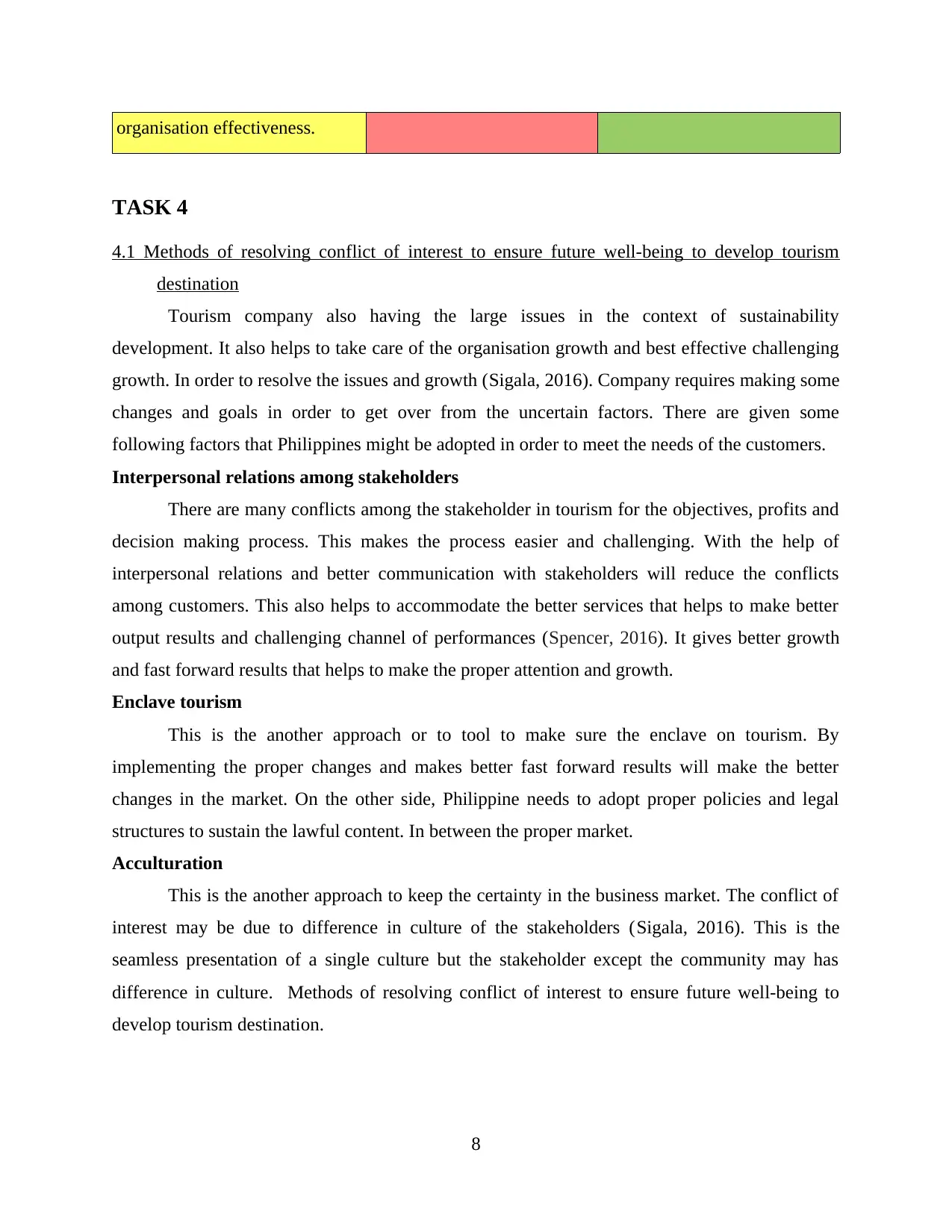
organisation effectiveness.
TASK 4
4.1 Methods of resolving conflict of interest to ensure future well-being to develop tourism
destination
Tourism company also having the large issues in the context of sustainability
development. It also helps to take care of the organisation growth and best effective challenging
growth. In order to resolve the issues and growth (Sigala, 2016). Company requires making some
changes and goals in order to get over from the uncertain factors. There are given some
following factors that Philippines might be adopted in order to meet the needs of the customers.
Interpersonal relations among stakeholders
There are many conflicts among the stakeholder in tourism for the objectives, profits and
decision making process. This makes the process easier and challenging. With the help of
interpersonal relations and better communication with stakeholders will reduce the conflicts
among customers. This also helps to accommodate the better services that helps to make better
output results and challenging channel of performances (Spencer, 2016). It gives better growth
and fast forward results that helps to make the proper attention and growth.
Enclave tourism
This is the another approach or to tool to make sure the enclave on tourism. By
implementing the proper changes and makes better fast forward results will make the better
changes in the market. On the other side, Philippine needs to adopt proper policies and legal
structures to sustain the lawful content. In between the proper market.
Acculturation
This is the another approach to keep the certainty in the business market. The conflict of
interest may be due to difference in culture of the stakeholders (Sigala, 2016). This is the
seamless presentation of a single culture but the stakeholder except the community may has
difference in culture. Methods of resolving conflict of interest to ensure future well-being to
develop tourism destination.
8
TASK 4
4.1 Methods of resolving conflict of interest to ensure future well-being to develop tourism
destination
Tourism company also having the large issues in the context of sustainability
development. It also helps to take care of the organisation growth and best effective challenging
growth. In order to resolve the issues and growth (Sigala, 2016). Company requires making some
changes and goals in order to get over from the uncertain factors. There are given some
following factors that Philippines might be adopted in order to meet the needs of the customers.
Interpersonal relations among stakeholders
There are many conflicts among the stakeholder in tourism for the objectives, profits and
decision making process. This makes the process easier and challenging. With the help of
interpersonal relations and better communication with stakeholders will reduce the conflicts
among customers. This also helps to accommodate the better services that helps to make better
output results and challenging channel of performances (Spencer, 2016). It gives better growth
and fast forward results that helps to make the proper attention and growth.
Enclave tourism
This is the another approach or to tool to make sure the enclave on tourism. By
implementing the proper changes and makes better fast forward results will make the better
changes in the market. On the other side, Philippine needs to adopt proper policies and legal
structures to sustain the lawful content. In between the proper market.
Acculturation
This is the another approach to keep the certainty in the business market. The conflict of
interest may be due to difference in culture of the stakeholders (Sigala, 2016). This is the
seamless presentation of a single culture but the stakeholder except the community may has
difference in culture. Methods of resolving conflict of interest to ensure future well-being to
develop tourism destination.
8
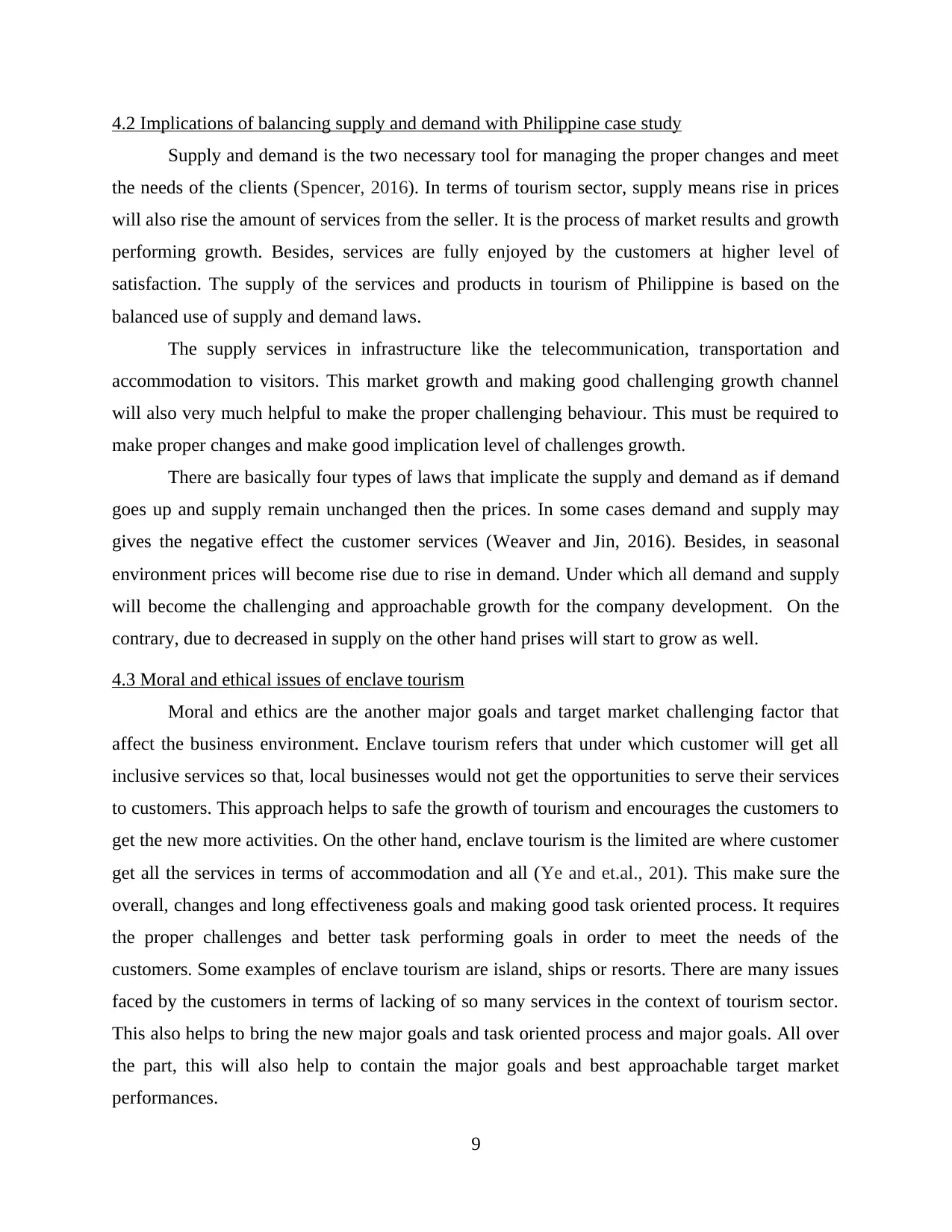
4.2 Implications of balancing supply and demand with Philippine case study
Supply and demand is the two necessary tool for managing the proper changes and meet
the needs of the clients (Spencer, 2016). In terms of tourism sector, supply means rise in prices
will also rise the amount of services from the seller. It is the process of market results and growth
performing growth. Besides, services are fully enjoyed by the customers at higher level of
satisfaction. The supply of the services and products in tourism of Philippine is based on the
balanced use of supply and demand laws.
The supply services in infrastructure like the telecommunication, transportation and
accommodation to visitors. This market growth and making good challenging growth channel
will also very much helpful to make the proper challenging behaviour. This must be required to
make proper changes and make good implication level of challenges growth.
There are basically four types of laws that implicate the supply and demand as if demand
goes up and supply remain unchanged then the prices. In some cases demand and supply may
gives the negative effect the customer services (Weaver and Jin, 2016). Besides, in seasonal
environment prices will become rise due to rise in demand. Under which all demand and supply
will become the challenging and approachable growth for the company development. On the
contrary, due to decreased in supply on the other hand prises will start to grow as well.
4.3 Moral and ethical issues of enclave tourism
Moral and ethics are the another major goals and target market challenging factor that
affect the business environment. Enclave tourism refers that under which customer will get all
inclusive services so that, local businesses would not get the opportunities to serve their services
to customers. This approach helps to safe the growth of tourism and encourages the customers to
get the new more activities. On the other hand, enclave tourism is the limited are where customer
get all the services in terms of accommodation and all (Ye and et.al., 201). This make sure the
overall, changes and long effectiveness goals and making good task oriented process. It requires
the proper challenges and better task performing goals in order to meet the needs of the
customers. Some examples of enclave tourism are island, ships or resorts. There are many issues
faced by the customers in terms of lacking of so many services in the context of tourism sector.
This also helps to bring the new major goals and task oriented process and major goals. All over
the part, this will also help to contain the major goals and best approachable target market
performances.
9
Supply and demand is the two necessary tool for managing the proper changes and meet
the needs of the clients (Spencer, 2016). In terms of tourism sector, supply means rise in prices
will also rise the amount of services from the seller. It is the process of market results and growth
performing growth. Besides, services are fully enjoyed by the customers at higher level of
satisfaction. The supply of the services and products in tourism of Philippine is based on the
balanced use of supply and demand laws.
The supply services in infrastructure like the telecommunication, transportation and
accommodation to visitors. This market growth and making good challenging growth channel
will also very much helpful to make the proper challenging behaviour. This must be required to
make proper changes and make good implication level of challenges growth.
There are basically four types of laws that implicate the supply and demand as if demand
goes up and supply remain unchanged then the prices. In some cases demand and supply may
gives the negative effect the customer services (Weaver and Jin, 2016). Besides, in seasonal
environment prices will become rise due to rise in demand. Under which all demand and supply
will become the challenging and approachable growth for the company development. On the
contrary, due to decreased in supply on the other hand prises will start to grow as well.
4.3 Moral and ethical issues of enclave tourism
Moral and ethics are the another major goals and target market challenging factor that
affect the business environment. Enclave tourism refers that under which customer will get all
inclusive services so that, local businesses would not get the opportunities to serve their services
to customers. This approach helps to safe the growth of tourism and encourages the customers to
get the new more activities. On the other hand, enclave tourism is the limited are where customer
get all the services in terms of accommodation and all (Ye and et.al., 201). This make sure the
overall, changes and long effectiveness goals and making good task oriented process. It requires
the proper challenges and better task performing goals in order to meet the needs of the
customers. Some examples of enclave tourism are island, ships or resorts. There are many issues
faced by the customers in terms of lacking of so many services in the context of tourism sector.
This also helps to bring the new major goals and task oriented process and major goals. All over
the part, this will also help to contain the major goals and best approachable target market
performances.
9
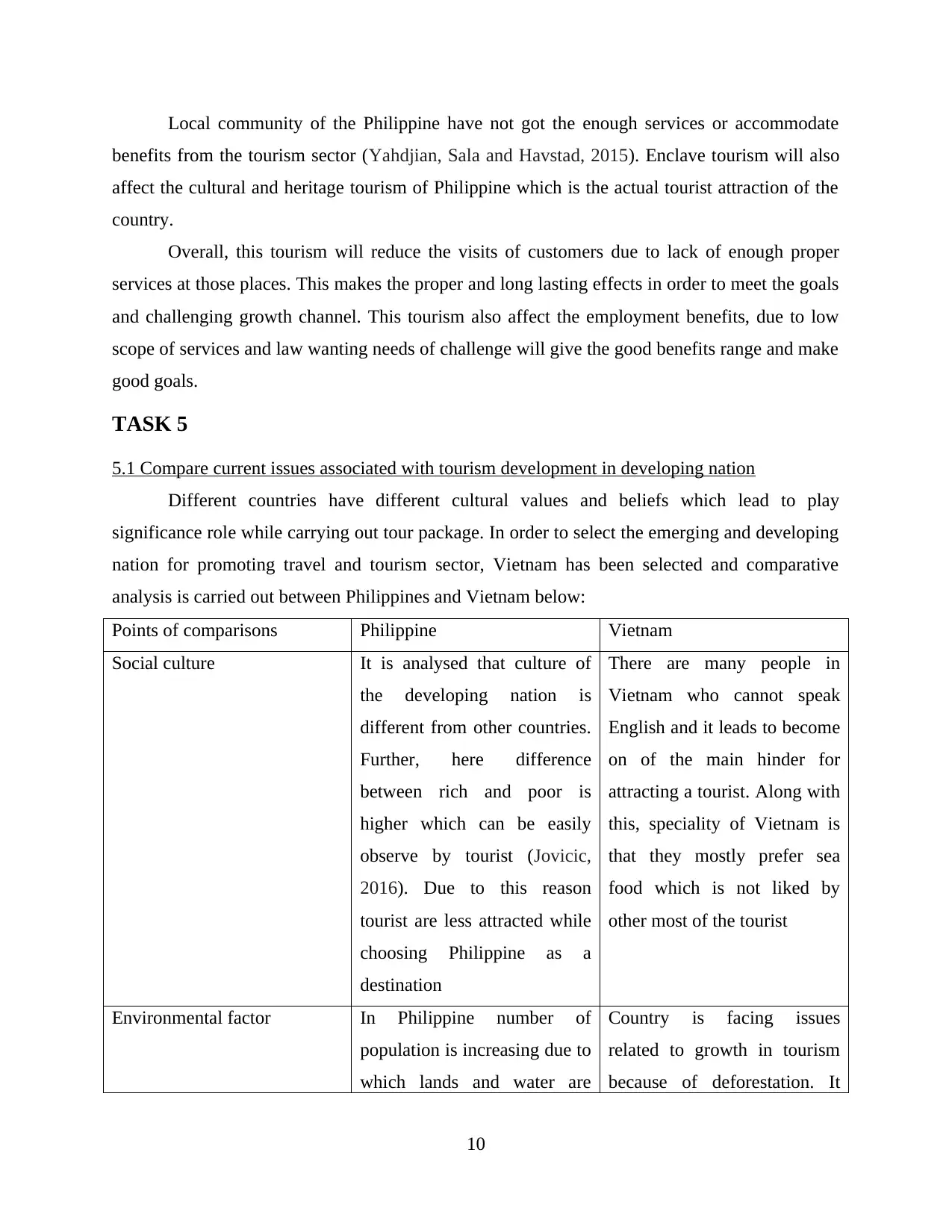
Local community of the Philippine have not got the enough services or accommodate
benefits from the tourism sector (Yahdjian, Sala and Havstad, 2015). Enclave tourism will also
affect the cultural and heritage tourism of Philippine which is the actual tourist attraction of the
country.
Overall, this tourism will reduce the visits of customers due to lack of enough proper
services at those places. This makes the proper and long lasting effects in order to meet the goals
and challenging growth channel. This tourism also affect the employment benefits, due to low
scope of services and law wanting needs of challenge will give the good benefits range and make
good goals.
TASK 5
5.1 Compare current issues associated with tourism development in developing nation
Different countries have different cultural values and beliefs which lead to play
significance role while carrying out tour package. In order to select the emerging and developing
nation for promoting travel and tourism sector, Vietnam has been selected and comparative
analysis is carried out between Philippines and Vietnam below:
Points of comparisons Philippine Vietnam
Social culture It is analysed that culture of
the developing nation is
different from other countries.
Further, here difference
between rich and poor is
higher which can be easily
observe by tourist (Jovicic,
2016). Due to this reason
tourist are less attracted while
choosing Philippine as a
destination
There are many people in
Vietnam who cannot speak
English and it leads to become
on of the main hinder for
attracting a tourist. Along with
this, speciality of Vietnam is
that they mostly prefer sea
food which is not liked by
other most of the tourist
Environmental factor In Philippine number of
population is increasing due to
which lands and water are
Country is facing issues
related to growth in tourism
because of deforestation. It
10
benefits from the tourism sector (Yahdjian, Sala and Havstad, 2015). Enclave tourism will also
affect the cultural and heritage tourism of Philippine which is the actual tourist attraction of the
country.
Overall, this tourism will reduce the visits of customers due to lack of enough proper
services at those places. This makes the proper and long lasting effects in order to meet the goals
and challenging growth channel. This tourism also affect the employment benefits, due to low
scope of services and law wanting needs of challenge will give the good benefits range and make
good goals.
TASK 5
5.1 Compare current issues associated with tourism development in developing nation
Different countries have different cultural values and beliefs which lead to play
significance role while carrying out tour package. In order to select the emerging and developing
nation for promoting travel and tourism sector, Vietnam has been selected and comparative
analysis is carried out between Philippines and Vietnam below:
Points of comparisons Philippine Vietnam
Social culture It is analysed that culture of
the developing nation is
different from other countries.
Further, here difference
between rich and poor is
higher which can be easily
observe by tourist (Jovicic,
2016). Due to this reason
tourist are less attracted while
choosing Philippine as a
destination
There are many people in
Vietnam who cannot speak
English and it leads to become
on of the main hinder for
attracting a tourist. Along with
this, speciality of Vietnam is
that they mostly prefer sea
food which is not liked by
other most of the tourist
Environmental factor In Philippine number of
population is increasing due to
which lands and water are
Country is facing issues
related to growth in tourism
because of deforestation. It
10
Paraphrase This Document
Need a fresh take? Get an instant paraphrase of this document with our AI Paraphraser
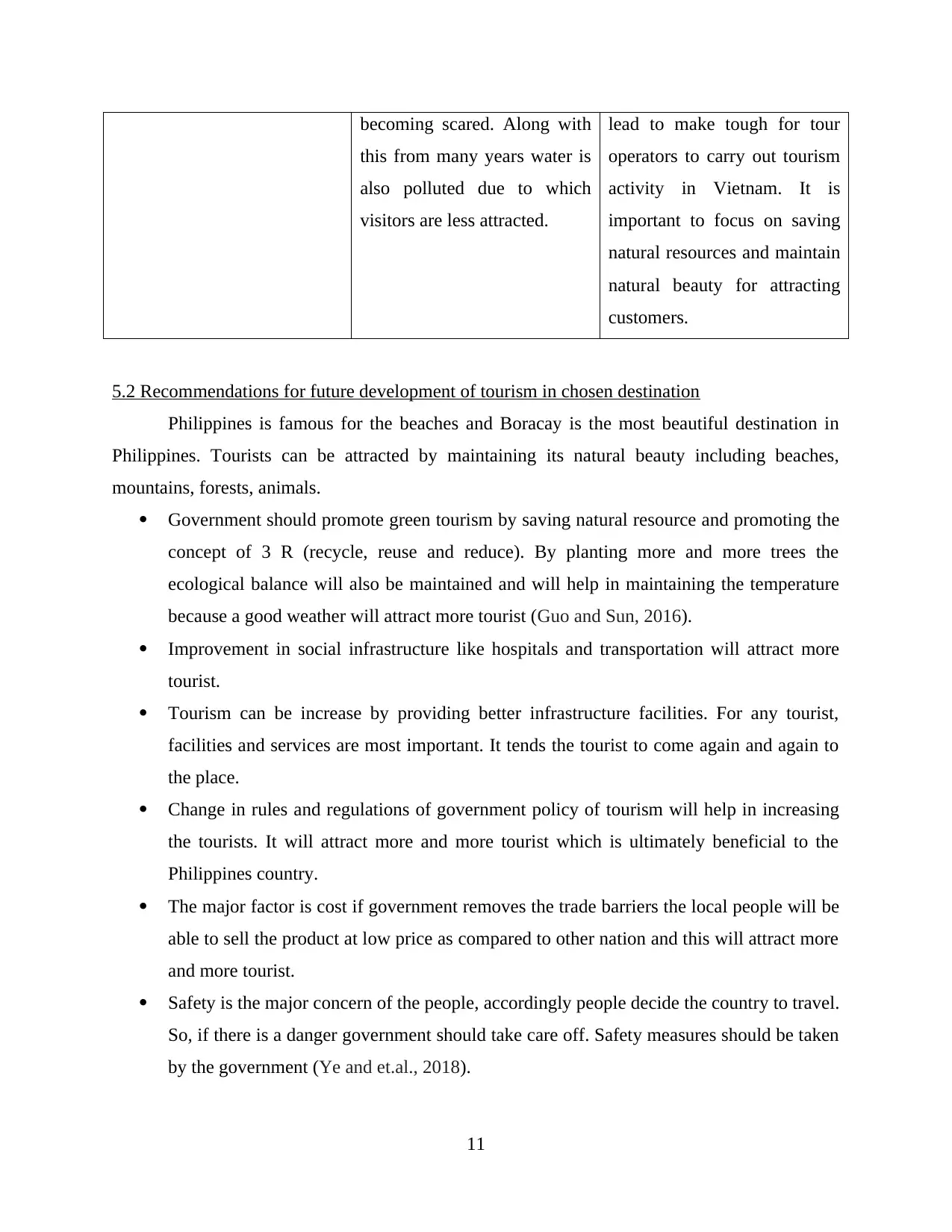
becoming scared. Along with
this from many years water is
also polluted due to which
visitors are less attracted.
lead to make tough for tour
operators to carry out tourism
activity in Vietnam. It is
important to focus on saving
natural resources and maintain
natural beauty for attracting
customers.
5.2 Recommendations for future development of tourism in chosen destination
Philippines is famous for the beaches and Boracay is the most beautiful destination in
Philippines. Tourists can be attracted by maintaining its natural beauty including beaches,
mountains, forests, animals.
Government should promote green tourism by saving natural resource and promoting the
concept of 3 R (recycle, reuse and reduce). By planting more and more trees the
ecological balance will also be maintained and will help in maintaining the temperature
because a good weather will attract more tourist (Guo and Sun, 2016).
Improvement in social infrastructure like hospitals and transportation will attract more
tourist.
Tourism can be increase by providing better infrastructure facilities. For any tourist,
facilities and services are most important. It tends the tourist to come again and again to
the place.
Change in rules and regulations of government policy of tourism will help in increasing
the tourists. It will attract more and more tourist which is ultimately beneficial to the
Philippines country.
The major factor is cost if government removes the trade barriers the local people will be
able to sell the product at low price as compared to other nation and this will attract more
and more tourist.
Safety is the major concern of the people, accordingly people decide the country to travel.
So, if there is a danger government should take care off. Safety measures should be taken
by the government (Ye and et.al., 2018).
11
this from many years water is
also polluted due to which
visitors are less attracted.
lead to make tough for tour
operators to carry out tourism
activity in Vietnam. It is
important to focus on saving
natural resources and maintain
natural beauty for attracting
customers.
5.2 Recommendations for future development of tourism in chosen destination
Philippines is famous for the beaches and Boracay is the most beautiful destination in
Philippines. Tourists can be attracted by maintaining its natural beauty including beaches,
mountains, forests, animals.
Government should promote green tourism by saving natural resource and promoting the
concept of 3 R (recycle, reuse and reduce). By planting more and more trees the
ecological balance will also be maintained and will help in maintaining the temperature
because a good weather will attract more tourist (Guo and Sun, 2016).
Improvement in social infrastructure like hospitals and transportation will attract more
tourist.
Tourism can be increase by providing better infrastructure facilities. For any tourist,
facilities and services are most important. It tends the tourist to come again and again to
the place.
Change in rules and regulations of government policy of tourism will help in increasing
the tourists. It will attract more and more tourist which is ultimately beneficial to the
Philippines country.
The major factor is cost if government removes the trade barriers the local people will be
able to sell the product at low price as compared to other nation and this will attract more
and more tourist.
Safety is the major concern of the people, accordingly people decide the country to travel.
So, if there is a danger government should take care off. Safety measures should be taken
by the government (Ye and et.al., 2018).
11
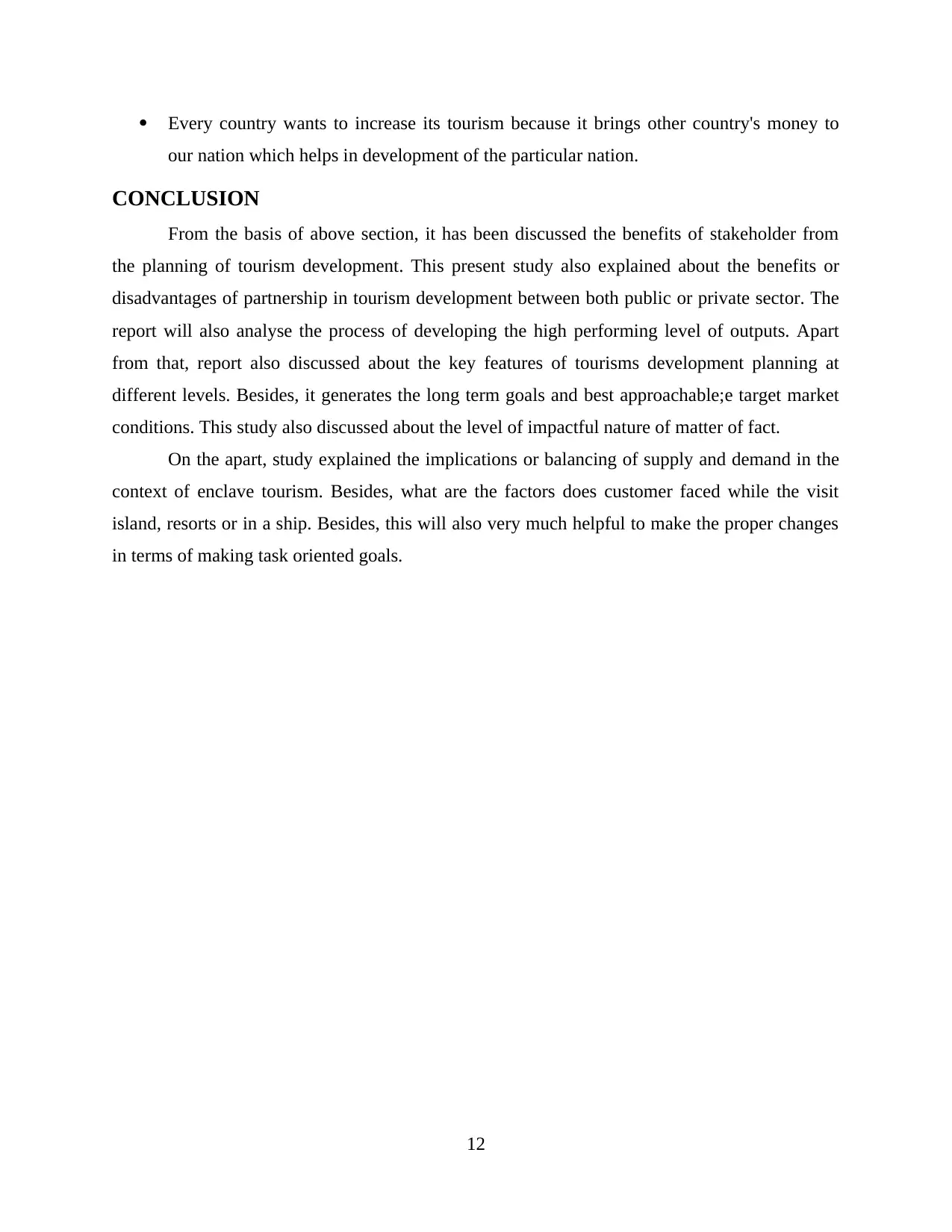
Every country wants to increase its tourism because it brings other country's money to
our nation which helps in development of the particular nation.
CONCLUSION
From the basis of above section, it has been discussed the benefits of stakeholder from
the planning of tourism development. This present study also explained about the benefits or
disadvantages of partnership in tourism development between both public or private sector. The
report will also analyse the process of developing the high performing level of outputs. Apart
from that, report also discussed about the key features of tourisms development planning at
different levels. Besides, it generates the long term goals and best approachable;e target market
conditions. This study also discussed about the level of impactful nature of matter of fact.
On the apart, study explained the implications or balancing of supply and demand in the
context of enclave tourism. Besides, what are the factors does customer faced while the visit
island, resorts or in a ship. Besides, this will also very much helpful to make the proper changes
in terms of making task oriented goals.
12
our nation which helps in development of the particular nation.
CONCLUSION
From the basis of above section, it has been discussed the benefits of stakeholder from
the planning of tourism development. This present study also explained about the benefits or
disadvantages of partnership in tourism development between both public or private sector. The
report will also analyse the process of developing the high performing level of outputs. Apart
from that, report also discussed about the key features of tourisms development planning at
different levels. Besides, it generates the long term goals and best approachable;e target market
conditions. This study also discussed about the level of impactful nature of matter of fact.
On the apart, study explained the implications or balancing of supply and demand in the
context of enclave tourism. Besides, what are the factors does customer faced while the visit
island, resorts or in a ship. Besides, this will also very much helpful to make the proper changes
in terms of making task oriented goals.
12
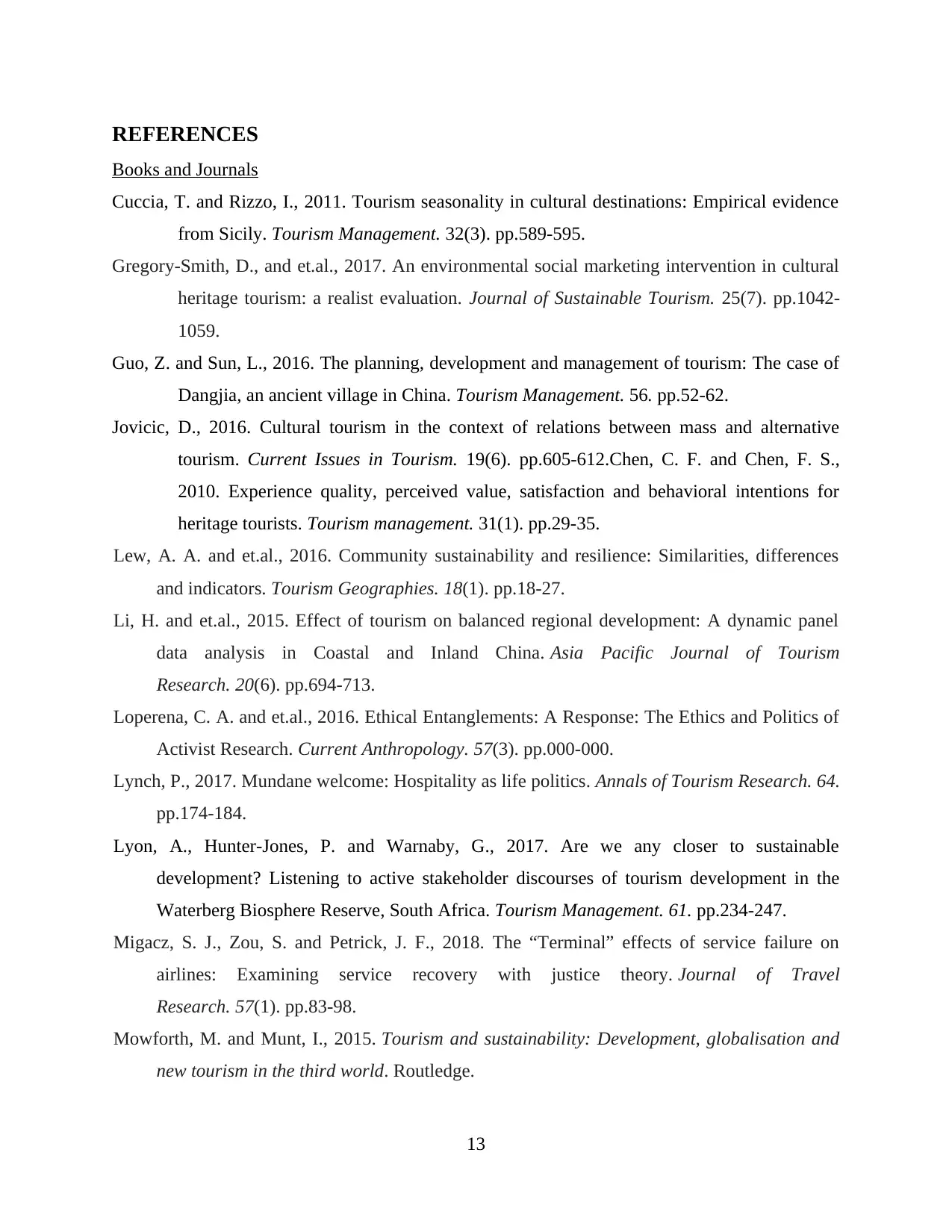
REFERENCES
Books and Journals
Cuccia, T. and Rizzo, I., 2011. Tourism seasonality in cultural destinations: Empirical evidence
from Sicily. Tourism Management. 32(3). pp.589-595.
Gregory-Smith, D., and et.al., 2017. An environmental social marketing intervention in cultural
heritage tourism: a realist evaluation. Journal of Sustainable Tourism. 25(7). pp.1042-
1059.
Guo, Z. and Sun, L., 2016. The planning, development and management of tourism: The case of
Dangjia, an ancient village in China. Tourism Management. 56. pp.52-62.
Jovicic, D., 2016. Cultural tourism in the context of relations between mass and alternative
tourism. Current Issues in Tourism. 19(6). pp.605-612.Chen, C. F. and Chen, F. S.,
2010. Experience quality, perceived value, satisfaction and behavioral intentions for
heritage tourists. Tourism management. 31(1). pp.29-35.
Lew, A. A. and et.al., 2016. Community sustainability and resilience: Similarities, differences
and indicators. Tourism Geographies. 18(1). pp.18-27.
Li, H. and et.al., 2015. Effect of tourism on balanced regional development: A dynamic panel
data analysis in Coastal and Inland China. Asia Pacific Journal of Tourism
Research. 20(6). pp.694-713.
Loperena, C. A. and et.al., 2016. Ethical Entanglements: A Response: The Ethics and Politics of
Activist Research. Current Anthropology. 57(3). pp.000-000.
Lynch, P., 2017. Mundane welcome: Hospitality as life politics. Annals of Tourism Research. 64.
pp.174-184.
Lyon, A., Hunter-Jones, P. and Warnaby, G., 2017. Are we any closer to sustainable
development? Listening to active stakeholder discourses of tourism development in the
Waterberg Biosphere Reserve, South Africa. Tourism Management. 61. pp.234-247.
Migacz, S. J., Zou, S. and Petrick, J. F., 2018. The “Terminal” effects of service failure on
airlines: Examining service recovery with justice theory. Journal of Travel
Research. 57(1). pp.83-98.
Mowforth, M. and Munt, I., 2015. Tourism and sustainability: Development, globalisation and
new tourism in the third world. Routledge.
13
Books and Journals
Cuccia, T. and Rizzo, I., 2011. Tourism seasonality in cultural destinations: Empirical evidence
from Sicily. Tourism Management. 32(3). pp.589-595.
Gregory-Smith, D., and et.al., 2017. An environmental social marketing intervention in cultural
heritage tourism: a realist evaluation. Journal of Sustainable Tourism. 25(7). pp.1042-
1059.
Guo, Z. and Sun, L., 2016. The planning, development and management of tourism: The case of
Dangjia, an ancient village in China. Tourism Management. 56. pp.52-62.
Jovicic, D., 2016. Cultural tourism in the context of relations between mass and alternative
tourism. Current Issues in Tourism. 19(6). pp.605-612.Chen, C. F. and Chen, F. S.,
2010. Experience quality, perceived value, satisfaction and behavioral intentions for
heritage tourists. Tourism management. 31(1). pp.29-35.
Lew, A. A. and et.al., 2016. Community sustainability and resilience: Similarities, differences
and indicators. Tourism Geographies. 18(1). pp.18-27.
Li, H. and et.al., 2015. Effect of tourism on balanced regional development: A dynamic panel
data analysis in Coastal and Inland China. Asia Pacific Journal of Tourism
Research. 20(6). pp.694-713.
Loperena, C. A. and et.al., 2016. Ethical Entanglements: A Response: The Ethics and Politics of
Activist Research. Current Anthropology. 57(3). pp.000-000.
Lynch, P., 2017. Mundane welcome: Hospitality as life politics. Annals of Tourism Research. 64.
pp.174-184.
Lyon, A., Hunter-Jones, P. and Warnaby, G., 2017. Are we any closer to sustainable
development? Listening to active stakeholder discourses of tourism development in the
Waterberg Biosphere Reserve, South Africa. Tourism Management. 61. pp.234-247.
Migacz, S. J., Zou, S. and Petrick, J. F., 2018. The “Terminal” effects of service failure on
airlines: Examining service recovery with justice theory. Journal of Travel
Research. 57(1). pp.83-98.
Mowforth, M. and Munt, I., 2015. Tourism and sustainability: Development, globalisation and
new tourism in the third world. Routledge.
13
Secure Best Marks with AI Grader
Need help grading? Try our AI Grader for instant feedback on your assignments.
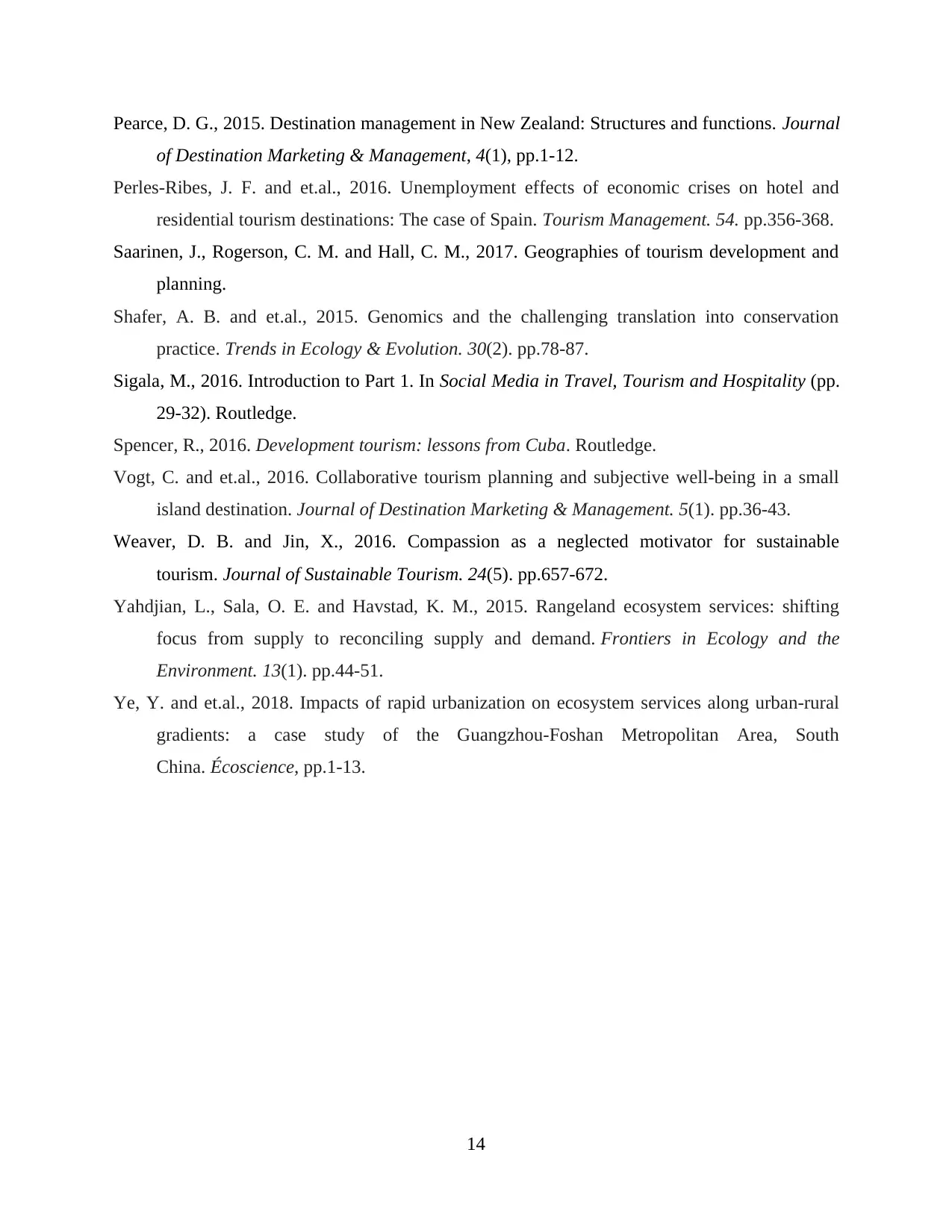
Pearce, D. G., 2015. Destination management in New Zealand: Structures and functions. Journal
of Destination Marketing & Management, 4(1), pp.1-12.
Perles-Ribes, J. F. and et.al., 2016. Unemployment effects of economic crises on hotel and
residential tourism destinations: The case of Spain. Tourism Management. 54. pp.356-368.
Saarinen, J., Rogerson, C. M. and Hall, C. M., 2017. Geographies of tourism development and
planning.
Shafer, A. B. and et.al., 2015. Genomics and the challenging translation into conservation
practice. Trends in Ecology & Evolution. 30(2). pp.78-87.
Sigala, M., 2016. Introduction to Part 1. In Social Media in Travel, Tourism and Hospitality (pp.
29-32). Routledge.
Spencer, R., 2016. Development tourism: lessons from Cuba. Routledge.
Vogt, C. and et.al., 2016. Collaborative tourism planning and subjective well-being in a small
island destination. Journal of Destination Marketing & Management. 5(1). pp.36-43.
Weaver, D. B. and Jin, X., 2016. Compassion as a neglected motivator for sustainable
tourism. Journal of Sustainable Tourism. 24(5). pp.657-672.
Yahdjian, L., Sala, O. E. and Havstad, K. M., 2015. Rangeland ecosystem services: shifting
focus from supply to reconciling supply and demand. Frontiers in Ecology and the
Environment. 13(1). pp.44-51.
Ye, Y. and et.al., 2018. Impacts of rapid urbanization on ecosystem services along urban-rural
gradients: a case study of the Guangzhou-Foshan Metropolitan Area, South
China. Écoscience, pp.1-13.
14
of Destination Marketing & Management, 4(1), pp.1-12.
Perles-Ribes, J. F. and et.al., 2016. Unemployment effects of economic crises on hotel and
residential tourism destinations: The case of Spain. Tourism Management. 54. pp.356-368.
Saarinen, J., Rogerson, C. M. and Hall, C. M., 2017. Geographies of tourism development and
planning.
Shafer, A. B. and et.al., 2015. Genomics and the challenging translation into conservation
practice. Trends in Ecology & Evolution. 30(2). pp.78-87.
Sigala, M., 2016. Introduction to Part 1. In Social Media in Travel, Tourism and Hospitality (pp.
29-32). Routledge.
Spencer, R., 2016. Development tourism: lessons from Cuba. Routledge.
Vogt, C. and et.al., 2016. Collaborative tourism planning and subjective well-being in a small
island destination. Journal of Destination Marketing & Management. 5(1). pp.36-43.
Weaver, D. B. and Jin, X., 2016. Compassion as a neglected motivator for sustainable
tourism. Journal of Sustainable Tourism. 24(5). pp.657-672.
Yahdjian, L., Sala, O. E. and Havstad, K. M., 2015. Rangeland ecosystem services: shifting
focus from supply to reconciling supply and demand. Frontiers in Ecology and the
Environment. 13(1). pp.44-51.
Ye, Y. and et.al., 2018. Impacts of rapid urbanization on ecosystem services along urban-rural
gradients: a case study of the Guangzhou-Foshan Metropolitan Area, South
China. Écoscience, pp.1-13.
14
1 out of 17
Related Documents
Your All-in-One AI-Powered Toolkit for Academic Success.
+13062052269
info@desklib.com
Available 24*7 on WhatsApp / Email
![[object Object]](/_next/static/media/star-bottom.7253800d.svg)
Unlock your academic potential
© 2024 | Zucol Services PVT LTD | All rights reserved.





